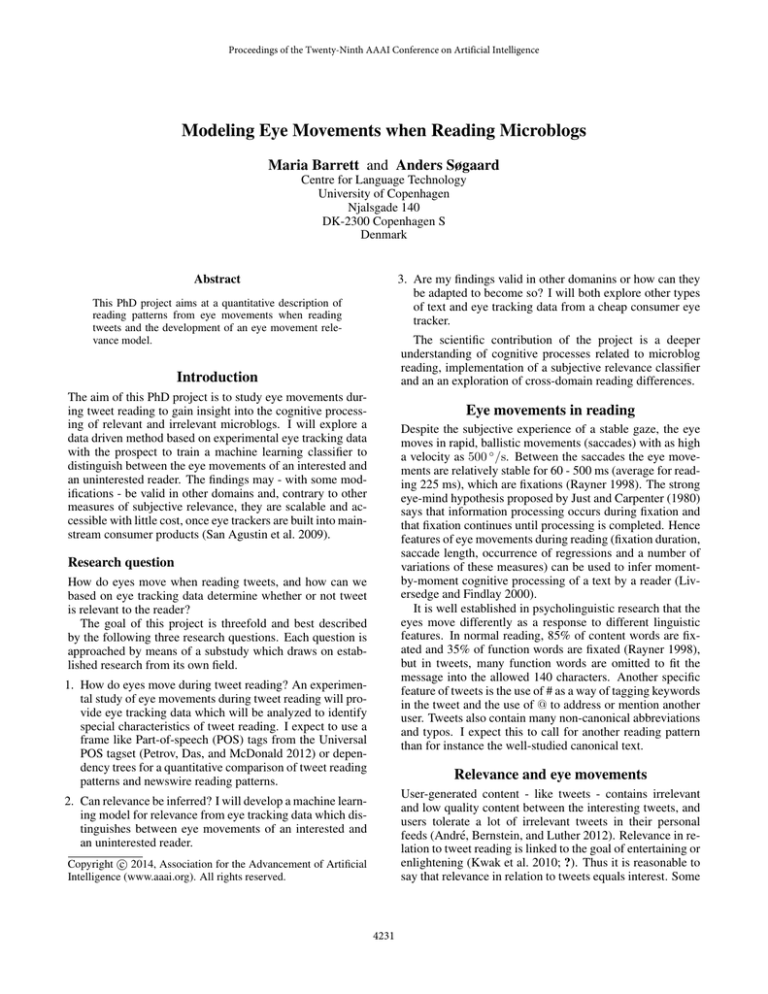
Proceedings of the Twenty-Ninth AAAI Conference on Artificial Intelligence
Modeling Eye Movements when Reading Microblogs
Maria Barrett and Anders Søgaard
Centre for Language Technology
University of Copenhagen
Njalsgade 140
DK-2300 Copenhagen S
Denmark
Abstract
3. Are my findings valid in other domanins or how can they
be adapted to become so? I will both explore other types
of text and eye tracking data from a cheap consumer eye
tracker.
This PhD project aims at a quantitative description of
reading patterns from eye movements when reading
tweets and the development of an eye movement relevance model.
The scientific contribution of the project is a deeper
understanding of cognitive processes related to microblog
reading, implementation of a subjective relevance classifier
and an an exploration of cross-domain reading differences.
Introduction
The aim of this PhD project is to study eye movements during tweet reading to gain insight into the cognitive processing of relevant and irrelevant microblogs. I will explore a
data driven method based on experimental eye tracking data
with the prospect to train a machine learning classifier to
distinguish between the eye movements of an interested and
an uninterested reader. The findings may - with some modifications - be valid in other domains and, contrary to other
measures of subjective relevance, they are scalable and accessible with little cost, once eye trackers are built into mainstream consumer products (San Agustin et al. 2009).
Eye movements in reading
Despite the subjective experience of a stable gaze, the eye
moves in rapid, ballistic movements (saccades) with as high
a velocity as 500 ◦ /s. Between the saccades the eye movements are relatively stable for 60 - 500 ms (average for reading 225 ms), which are fixations (Rayner 1998). The strong
eye-mind hypothesis proposed by Just and Carpenter (1980)
says that information processing occurs during fixation and
that fixation continues until processing is completed. Hence
features of eye movements during reading (fixation duration,
saccade length, occurrence of regressions and a number of
variations of these measures) can be used to infer momentby-moment cognitive processing of a text by a reader (Liversedge and Findlay 2000).
It is well established in psycholinguistic research that the
eyes move differently as a response to different linguistic
features. In normal reading, 85% of content words are fixated and 35% of function words are fixated (Rayner 1998),
but in tweets, many function words are omitted to fit the
message into the allowed 140 characters. Another specific
feature of tweets is the use of # as a way of tagging keywords
in the tweet and the use of @ to address or mention another
user. Tweets also contain many non-canonical abbreviations
and typos. I expect this to call for another reading pattern
than for instance the well-studied canonical text.
Research question
How do eyes move when reading tweets, and how can we
based on eye tracking data determine whether or not tweet
is relevant to the reader?
The goal of this project is threefold and best described
by the following three research questions. Each question is
approached by means of a substudy which draws on established research from its own field.
1. How do eyes move during tweet reading? An experimental study of eye movements during tweet reading will provide eye tracking data which will be analyzed to identify
special characteristics of tweet reading. I expect to use a
frame like Part-of-speech (POS) tags from the Universal
POS tagset (Petrov, Das, and McDonald 2012) or dependency trees for a quantitative comparison of tweet reading
patterns and newswire reading patterns.
Relevance and eye movements
User-generated content - like tweets - contains irrelevant
and low quality content between the interesting tweets, and
users tolerate a lot of irrelevant tweets in their personal
feeds (André, Bernstein, and Luther 2012). Relevance in relation to tweet reading is linked to the goal of entertaining or
enlightening (Kwak et al. 2010; ?). Thus it is reasonable to
say that relevance in relation to tweets equals interest. Some
2. Can relevance be inferred? I will develop a machine learning model for relevance from eye tracking data which distinguishes between eye movements of an interested and
an uninterested reader.
c 2014, Association for the Advancement of Artificial
Copyright Intelligence (www.aaai.org). All rights reserved.
4231
studies has looked at the link between gaze patterns and relevance: Buscher, Dengel, and van Elst (2008) and Brooks et
al. (2006) have described eye movements qualitatively when
reading relevant and irrelevant text in a known relevance
task. Gwizdka (2014) have explored relevance in eye movements quantitatively in a known relevance task when reading
news articles. Salojärvi et al. (2003) and Ajanki et al. (2009)
have found that eye tracking data can reliably model user interest. I expect to use eye movement features of relevance
inspired by Salojärvi et al., and Ajanki et al.. Similar to Salojärvi et al. I expect to find across-subjects characteristics.
Salojärvi et al. also used pupil dilation as a feature. Pupil
dilation isolated from gaze paths is well studied in relation to affection and cognitive states and has been linked to
both positive and negative excitement (Partala and Surakka
2003) as well as frustration and workload (Marshall 2007).
Subjective relevance inferred from eye movements during
tweet reading has not been explored besides Counts and
Fisher (2011), but detailed reading pattern was not subject to
their study. The desired goal is to identify reliable gaze patterns related to interest and disinterest without using pupil
dilation as a metric, because this measurement entails constraints to data collection: the lighting conditions must be
very controlled, which can only be realized in a lab. Instead
I intend to to explore whether my conclusions are valid with
data from consumer eye trackers like The Eye Tribe’s $99
eye tracker (San Agustin et al. 2009).
ceedings of the International Conference on Intelligent User
Interfaces’06.
Buscher, G.; Dengel, A.; and van Elst, L. 2008. Attentive
documents: Eye tracking as implicit feedback for information retrieval and beyond. In CHI ’08: CHI ’08 extended
abstracts on Human factors in computing systems.
Counts, S., and Fisher, K. 2011. Taking it all in? visual
attention in microblog consumption. In Proceedings of the
Fifth International Conference on Weblogs and Social Media.
Gwizdka, J. 2014. News stories relevance effects on eyemovements. In Proceedings of the Symposium on Eye Tracking Research and Applications, 283–286. ACM.
Just, M. A., and Carpenter, P. A. 1980. A theory of reading:
From eye fixations to comprehension. Psychological Review
87(4):329–354.
Kwak, H.; Lee, C.; Park, H.; and Moon, S. 2010. What is
twitter, a social network or a news media? In WWW ’10:
Proceedings of the 19th international conference on World
wide web, 591–600. New York, NY, USA: ACM.
Liversedge, S. P., and Findlay, J. M. 2000. Saccadic eye
movements and cognition. Trends in Cognitive Sciences
4(1):6–14.
Marshall, S. P. 2007. Identifying cognitive state from
eye metrics. Aviation, Space, and Environmental Medicine
78(5).
Partala, T., and Surakka, V. 2003. Pupil size variation as an
indication of affective processing. Int. J. Human-Computer
Studies 59(1-2):185–198.
Petrov, S.; Das, D.; and McDonald, R. 2012. A universal part-of-speech tagset. In Calzolari, N.; Choukri, K.;
Declerck, T.; Doğan, M. U.; Maegaard, B.; Mariani, J.;
Moreno, A.; Odijk, J.; and Piperidis, S., eds., Proceedings of
the Eight International Conference on Language Resources
and Evaluation (LREC’12). Istanbul, Turkey: European
Language Resources Association (ELRA).
Rayner, K. 1998. Eye movements in reading and information processing: 20 years of research. Psychological Bulletin
372–422.
Salojärvi, J.; Kojo, I.; Simola, J.; and Kaski, S. 2003. Can
relevance be inferred from eye movements in information
retrieval? In Proceedings of the 4th Workshop on SelfOrganizing Maps, 261–266.
San Agustin, J.; Skovsgaard, H.; Hansen, J. P.; and Hansen,
D. W. 2009. Low-cost gaze interaction: Ready to deliver the
promises. In CHI ’09 Extended Abstracts on Human Factors
in Computing Systems, CHI EA ’09, 4453–4458. New York,
NY, USA: ACM.
Brief timeline
All work will be carried out by myself except annotating
tweets which has been done by my research group.
Sep 2014 - Nov 2014 Literature study and plan experiment
Dec 2014 - Jan 2015 Perform experiment and preliminary analysis
Feb 2015 - Aug 2015 Analysis and develop relevance model
Sep 2015 - Dec 2015 Sub-study: develop and evaluate reader model
Jan 2016 - Aug 2016 Implement and evaluate relevance model
Sep 2016 - Mar 2017 Explore other domains
Apr 2017 - Sep 2017 Write thesis
References
Ajanki, A.; Hardoon, D. R.; Kaski, S.; Puolamäki, K.; and
Shawe-Taylor, J. 2009. Can eyes reveal interest? implicit queries from gaze patterns. User Modeling and UserAdapted Interaction 19(4):307–339.
André, P.; Bernstein, M.; and Luther, K. 2012. Who gives a
tweet?: Evaluating microblog content value. In Proceedings
of the ACM 2012 Conference on Computer Supported Cooperative Work, CSCW ’12, 471–474. New York, NY, USA:
ACM.
Brooks, P.; Phang, K. Y.; Bradley, R.; Oard, D.; White, R.;
and Guimbretiere, F. 2006. Measuring the utility of gaze
detection for task modeling: A preliminary study. In Pro-
4232






